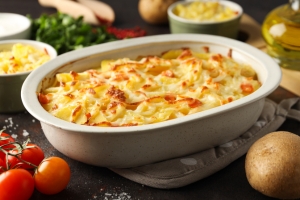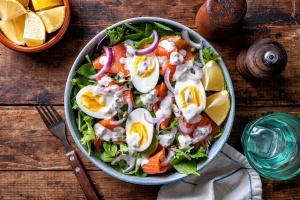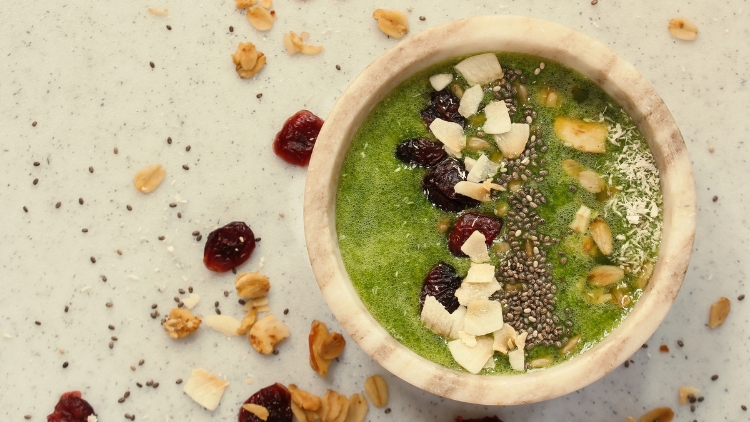Imagine waking up to a breakfast that’s not only delicious but also helps you manage your blood sugar levels. No more bland, boring meals! Instead, picture a vibrant, cheesy casserole brimming with fresh vegetables and savory flavors, all while keeping your health goals in check. Intrigued? Let’s dive into the world of diabetic-friendly breakfast casseroles that are as kind to your body as they are to your taste buds.
Why Breakfast Casseroles are a Diabetic’s Best Friend
Breakfast is often hailed as the most important meal of the day, and this rings especially true for those managing diabetes. A balanced breakfast helps regulate blood sugar levels, providing sustained energy and preventing those dreaded mid-morning crashes. Casseroles are a fantastic option because they can be packed with protein, fiber, and healthy fats, the trifecta for blood sugar control. Plus, they’re incredibly versatile and can be made ahead of time, making them perfect for busy mornings.
Building the Perfect Diabetic-Friendly Casserole
Creating a breakfast casserole that fits into a diabetic meal plan involves a few key strategies:
1. Load Up on Non-Starchy Vegetables:
Vegetables like spinach, mushrooms, peppers, and zucchini are your secret weapons. They add volume, flavor, and essential nutrients without significantly impacting your blood sugar. Aim to fill at least half your casserole dish with these colorful powerhouses.
2. Choose Lean Protein Sources:
Protein is crucial for satiety and blood sugar management. Opt for lean options like chicken, turkey, or fish. If you’re using red meat, choose lean cuts and trim away excess fat. Eggs are another excellent protein source and a staple in many casseroles.
3. Be Mindful of Carbohydrates:
While carbohydrates are necessary, it’s essential to choose complex carbs over simple ones. Instead of white bread or potatoes, incorporate small amounts of whole grains or low-carb alternatives like cauliflower rice.
4. Don’t Fear Healthy Fats:
Healthy fats are essential for overall health and can help slow down the absorption of glucose, preventing blood sugar spikes. Avocado, nuts, seeds, and olive oil are all great additions to your casseroles.
5. Watch the Cheese:
Cheese can add flavor and richness, but it can also be high in fat and calories. Use it sparingly and choose lower-fat varieties when possible.
10 Delicious Diabetic Breakfast Casseroles Under 500 Calories

Now, let’s get to the good stuff! Here are 10 mouthwatering breakfast casserole recipes that are not only delicious but also diabetic-friendly and under 500 calories per serving.
“Veggie Fiesta”: This vibrant casserole is a celebration of vegetables! It’s packed with flavor and provides a good source of vitamins and antioxidants with eggs, bell peppers, onion, mushrooms, spinach, zucchini, Italian seasoning, and garlic. Simply sauté the vegetables, whisk the eggs, combine everything, and bake.
“Mediterranean Morning”: Transport your tastebuds to the Mediterranean with this flavorful combination of eggs, crumbled feta cheese, chopped bell peppers, Kalamata olives, oregano, and garlic. Sauté the garlic and peppers, whisk the eggs with oregano, combine everything, top with feta and olives, and bake.
“Cheesy Broccoli and Cauliflower”: This casserole is packed with healthy cruciferous vegetables and cheesy goodness. It features broccoli, cauliflower, eggs, cheddar cheese, heavy cream, garlic powder, and onion powder. Blanch or steam the vegetables, whisk the eggs with the seasonings and cream, combine everything, top with cheese, and bake.
Sausage and Mushroom Breakfast Casserole: This hearty and savory casserole features the classic combination of sausage (choose a low-carb option) and mushrooms with eggs, cheese, onion, and heavy cream. Brown the sausage, sauté the mushrooms and onion, whisk the eggs with cream, combine everything, and bake.
Bell Pepper and Bacon Breakfast Casserole: This colorful casserole is a great way to use up leftover bell peppers, and the bacon adds a smoky, salty kick. The recipe calls for bell peppers, bacon, eggs, cheese, onion, and heavy cream. Cook the bacon, sauté the peppers and onion, whisk the eggs with cream, combine everything, and bake.
Zucchini and Ham Breakfast Casserole: This casserole is a great way to use up zucchini, and it’s packed with flavor from the ham. Combine zucchini, ham, eggs, cheese, onion, and heavy cream. Sauté the zucchini, ham, and onion, whisk the eggs with cream, combine everything, and bake.
“Creamy Ham and Asparagus Delight”: This elegant casserole combines the salty flavor of ham with the freshness of asparagus. It features ham, asparagus, eggs, Gruyère cheese, heavy cream, and Dijon mustard. Blanch the asparagus, whisk the eggs with cream and mustard, combine everything, top with cheese, and bake.
Tomato and Basil Breakfast Casserole: This fresh and flavorful casserole is perfect for summer mornings. Combine tomatoes, fresh basil, eggs, cheese (mozzarella or Parmesan), garlic, and heavy cream. Sauté the garlic, whisk the eggs with cream, combine everything, top with cheese, and bake.
“Mushroom Medley”: This earthy and savory casserole is packed with different types of mushrooms, along with eggs, onion, garlic, thyme, and heavy cream. Sauté the mushrooms, onion, and garlic with thyme, whisk the eggs with cream, combine everything, and bake.
“Cheesy Kale and Bacon”: This casserole combines the crispy goodness of bacon with the nutritional power of kale. It includes kale, bacon, eggs, cheddar cheese, garlic, and heavy cream. Cook the bacon, sauté the kale and garlic, whisk the eggs with cream, combine everything, top with cheese, and bake.
Living with diabetes doesn’t mean sacrificing flavor or enjoyment when it comes to food. These 10 breakfast casseroles are proof that you can create satisfying meals that support your health goals without compromising on taste. By focusing on whole foods, lean proteins, and healthy fats, you can take charge of your mornings and start your day with energy and confidence. So go ahead, experiment with these recipes, discover your new favorite breakfast, and embrace a healthier, happier you!
Enjoyed these low-calorie diabetic breakfast casseroles? Share the goodness on Pinterest to help others start their day right!

Resources:
- Impact of Vegetable-Rich Breakfasts on Glycemic Control in Type 2 Diabetes
- The Role of Dietary Fat in Glucose Absorption and Insulin Response
- Protein-Enriched Breakfast and Satiety Hormones in Adults with Diabetes
- Comparison of Glycemic Response to Different Breakfast Carbohydrate Sources in Diabetic Individuals
- Effects of a Calorie-Controlled, High-Protein Diet on Weight Loss and Glycemic Management in Obese Patients with Type 2 Diabetes







12 Responses
These recipes sound delicious, but I’m a little concerned about the use of heavy cream and cheese in so many of them. I thought people with diabetes were supposed to limit saturated fat. Are these casseroles really healthy for someone with diabetes? Also, the article mentions being mindful of carbs but doesn’t give specific carb counts for each recipe. That would be really helpful for meal planning.
Hi Emily, thanks for your comment! You’re right to be mindful of saturated fat intake, especially when managing diabetes. While these recipes do include heavy cream and cheese, they are used in moderation and are balanced with plenty of vegetables and lean protein.
It’s important to remember that dietary recommendations can vary based on individual needs and overall dietary patterns. Recent research suggests that the impact of saturated fat on health may be more nuanced than previously thought, and it might depend on the overall context of the diet. For instance, some studies suggest that full-fat dairy might have a neutral or even positive effect on heart health markers.
However, if you’re concerned about saturated fat, you can definitely make adjustments to these recipes. Here are a few options:
Reduce the amount of cheese: You can use half the amount called for in the recipe or choose a strong-flavored cheese so you can use less while still getting a good flavor.
Substitute heavy cream: You can use half-and-half, whole milk, or even unsweetened almond milk to reduce the fat content. Keep in mind that this might slightly alter the texture of the casserole.
Choose lower-fat cheese: Opt for part-skim mozzarella or other lower-fat cheese varieties.
Regarding the carb counts, you make an excellent point. While the article emphasizes the importance of non-starchy vegetables and lean proteins, providing specific carb counts for each recipe would indeed be more helpful for those strictly monitoring their intake. I’ll definitely consider adding that information in an update!
In the meantime, you can use online resources or apps to calculate the nutritional information based on the ingredients and portion sizes. Remember that the carb content will vary depending on the specific ingredients you use and any modifications you make.
It’s also worth noting that the total amount of carbs is not the only thing to consider. The type of carbohydrate is also important. These casseroles generally focus on non-starchy vegetables, which have a lower glycemic index and a lesser impact on blood sugar levels compared to refined grains or starchy vegetables.
Ultimately, it’s always best to consult with a doctor or a registered dietitian for personalized dietary advice. They can help you create a meal plan that fits your individual needs and health goals, taking into account your specific type of diabetes, any medications you’re taking, and your overall health status.
I’m always looking for make-ahead breakfast options, but I’m worried about food safety. How long can these casseroles be stored in the refrigerator, and do you have any tips for reheating them without them becoming dry or rubbery? Also, can any of these be frozen for longer storage?
Hi Ashley, that’s a great question! Food safety is definitely a priority, especially when it comes to make-ahead meals.
Generally, cooked egg dishes like these casseroles can be safely stored in the refrigerator for up to 3-4 days. Make sure to let the casserole cool completely before covering it tightly and placing it in the fridge.
For reheating, here are a few tips to prevent dryness:
Oven: Reheat individual portions or the whole casserole in a preheated oven at 350°F (175°C) until heated through. Covering the casserole with foil can help retain moisture.
Microwave: For a quicker option, reheat individual portions in the microwave. Using a microwave-safe cover can help prevent splattering and retain moisture. Start with a shorter reheating time and add more as needed, as microwaves can sometimes heat unevenly.
Skillet: You can reheat some casseroles (especially those without a creamy sauce) in a skillet on the stovetop over medium heat. Adding a splash of water or broth can help prevent sticking and add moisture.
As for freezing, many of these casseroles can be frozen for longer storage. However, the texture might change slightly upon thawing and reheating. Casseroles with a higher vegetable content tend to release more moisture when frozen and thawed.
Here are some tips for freezing:
Cool completely: Let the casserole cool completely before freezing to prevent ice crystals from forming.
Portion it out: Divide the casserole into individual portions before freezing for easier thawing and reheating.
Wrap tightly: Wrap each portion tightly in plastic wrap and then place it in a freezer-safe bag or container.
Label and date: Label the container with the name of the casserole and the date it was made.
Frozen casseroles can generally be stored for up to 2-3 months. To thaw, transfer the desired portion to the refrigerator overnight. Then, reheat using one of the methods mentioned above. You can also bake it from frozen. If you do so, add about 50% to the original baking time.
Keep in mind that some ingredients freeze better than others. Casseroles with a lot of dairy or creamy sauces might separate slightly upon thawing. If you’re concerned about texture changes, you could experiment with freezing a small portion first to see how it holds up.
I hope these tips help you enjoy these make-ahead breakfast casseroles safely and conveniently!
Alright, I’m intrigued. These casseroles sound pretty good, but I’m a bit of a breakfast casserole newbie. My question is, how do these things actually stay under 500 calories? Seems like once you add cheese and eggs, you’re already in calorie-overload territory. Also, “heavy cream”? Isn’t that, like, the devil for someone trying to watch their weight and sugar? I’m trying to be healthy here, not gain another 10 pounds! Also, can I freeze these things? I’m a busy woman!
Patricia, you’re speaking my language! It’s all about smart choices and portion control, my friend. We’re using lean proteins, tons of veggies (which are low in calories), and being mindful of the cheese and heavy cream. A little goes a long way, flavor-wise. Think of heavy cream as a flavor enhancer, not the main event, and some recipes don’t use it at all. We use it in moderation to add richness without going overboard. It is a healthy fat that helps with satiety. As for freezing, absolutely! Most of these casseroles freeze beautifully. Just let them cool completely, then wrap them tightly in plastic wrap and foil, or use an airtight container. They should last for a couple of months in the freezer. Perfect for those busy mornings!
Okay, “Veggie Fiesta” sounds fun, but what if I have a picky eater at home who thinks vegetables are the enemy? Any tips for sneaking those veggies in without causing a breakfast mutiny? Also, I’m a bit confused about the “low-carb” sausage. What exactly does that mean, and where do I find it? Is it like a special health food store thing, or can I just grab it at my regular supermarket? Help a sister out!
Jennifer, I hear you! Veggies can be a tough sell sometimes. My trick? Finely chop or grate those veggies. Zucchini and carrots practically disappear into a casserole when grated. You can also try pureeing some cooked vegetables (like butternut squash or sweet potato) and mixing them into the egg mixture. They’ll add sweetness and a creamy texture without being obvious. For the “low-carb” sausage, it just means it has fewer carbohydrates than regular sausage, usually because it has less added sugar or fillers. Many regular supermarkets carry them now! Look in the breakfast meat section, and check the labels for carbohydrate content. You can also find them at health food stores. You got this!
These casseroles sound delicious, but ‘diabetic-friendly’ usually means ‘flavor-free’ in my experience. Are these actually tasty, or will I be choking down bland eggs and veggies? Also, 500 calories seems like a lot for breakfast. Will I be starving by 10 AM? And can I add hot sauce? Because everything is better with hot sauce.
Barbara, I hear your concerns! ‘Diabetic-friendly’ shouldn’t mean sacrificing flavor, and these casseroles are anything but bland. We’re talking about flavorful cheeses, savory meats, and aromatic spices! Trust me, your taste buds will be doing a happy dance. As for the 500 calories, it might sound like a lot, but it’s designed to be a substantial, balanced meal that will keep you full and energized until lunchtime. We’re loading up on protein and healthy fats, which are key for satiety and blood sugar control. No mid-morning hunger pangs here! And YES, absolutely add hot sauce! Spice is the spice of life, and it can add a delicious kick to your casserole. Just be mindful of the sodium content if you’re watching your salt intake. Enjoy that fiery flavor!
Okay, these recipes look intriguing, but I’m no Martha Stewart in the kitchen. Are these casseroles complicated to make? And what if I’m allergic to eggs? Can I still enjoy these recipes? Also, my husband doesn’t have diabetes. Can he eat these, or will he think they taste like ‘diet food’?
Pat, don’t worry, you don’t need to be a culinary expert to whip up these casseroles! They’re designed to be easy and beginner-friendly. Most of them involve simply sautéing some veggies, whisking eggs, combining everything in a dish, and baking. Easy peasy! As for the egg allergy, that’s a bit trickier since eggs are a key ingredient in most of these recipes. But don’t despair! You might be able to find some egg substitutes that work, like flax eggs or a commercial egg replacer. It might take a bit of experimentation to get the texture right. And about your husband, I bet he’ll love these casseroles too! They’re packed with flavor and satisfying ingredients that anyone can enjoy. They definitely don’t taste like ‘diet food’ – they’re just wholesome, delicious meals. He might even ask for seconds!